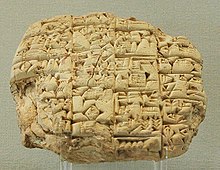ಕ್ಯುನಿಫಾರಂ ಲಿಪಿ
| Cuneiform | |
|---|---|
 Trilingual cuneiform inscription of Xerxes at Van Fortress in Turkey, written in Old Persian, Akkadian, and Elamite | |
| ವರ್ಗ | Logographic and syllabic |
| ಭಾಷೆಗಳು | Akkadian, Eblaite, Elamite, Hattic, Hittite, Hurrian, Luwian, Sumerian, Urartian, Old Persian |
| ಸಮಯಾವದಿ | c. 31st century BC to 1st century AD |
| Parent systems |
(Proto-writing)
|
| Child systems | none; influenced shape of Ugaritic apparently inspired Old Persian |
| ISO 15924 | Xsux, 020 |
| Direction | Left-to-right |
| Unicode alias | Cuneiform |
| Unicode range | U+12000 to U+123FF Cuneiform, U+12400 to U+1247F Cuneiform Numbers and Punctuation |

ಕ್ಯುನಿಫಾರಂ ಲಿಪಿ ವಿಶ್ವದ ಇತಿಹಾಸದಲ್ಲೇ ಮೊದಲನೆಯದಾದ ಮತ್ತು ಪ್ರಾಚೀನ ಸುಮೇರಿಯನರು ಬಳಸುತ್ತಿದ್ದ ಲಿಪಿ[೧]. ಈ ಲಿಪಿಯ ಚಿಹ್ನೆಗಳು ನಲ್ಲಿ ಬೆಣೆ, ಬಾಣದ ತುದಿ ಮೊದಲಾದ ಆಕಾರಗಳಲ್ಲಿವೆ. ಲ್ಯಾಟಿನಿನಲ್ಲಿ ಕ್ಯೂನಿಫಾರಂನ ಅರ್ಥ ಬೆಣೆಯಾಕಾರ ಎಂದಾಗುತ್ತದೆ[೨].
ಉಗಮ
[ಬದಲಾಯಿಸಿ]ಈ ಲಿಪಿಯ ಉಗಮ ಯಾವಾಗ ಎಂದು ತಿಳಿಯದಿದ್ದರೂ ಕ್ರಿ.ಪೂ. ೪ನೆಯ ಸಹಸ್ರಮಾನದ ಕಾಲದಿಂದ ಇದು ಬಳಕೆಯಲ್ಲಿತ್ತು. ಇದು ಮೊದಲಿಗೆ ಚಿತ್ರಲಿಪಿಯಾಗಿತ್ತು. ಕಾಲಕ್ರಮದಲ್ಲಿ ಇದು ಶಬ್ದವರ್ಣ (ವರ್ಡ್-ಸಿಲಬಿಕ್) ಲಿಪಿಯಾಗಿ ತದನಂತರ ಕೀಲಲಿಪಿ ಆಯಿತು.
ಸ್ವರೂಪ
[ಬದಲಾಯಿಸಿ]


ಇದರಲ್ಲಿ ಅನೇಕ ಬಗೆಯ ಚಿಹ್ನೆಗಳಿವೆ. ಕೆಲವು ಏಕಧ್ವನಿಸೂಚಕಗಳು ಮತ್ತೆ ಕೆಲವು ಬಹುಧ್ವನಿಸೂಚಕಗಳು. ಇದರಿಂದುಂಟಾಗುವ ಸಂದಿಗ್ಧತೆಯನ್ನು ನಿವಾರಿಸಲು ಪದದ ಮುಂದೆ ಅಥವಾ ಹಿಂದೆ ನಿರ್ದೇಶಕ ಚಿಹ್ನೆಗಳನ್ನು ಬರೆಯುತ್ತಿದ್ದರು. ದೇಶ, ಬೆಟ್ಟ, ದೇವತೆ, ಪಕ್ಷಿ, ಪ್ರಾಣಿ ಮುಂತಾದ ನಿರ್ದೇಶಕ ಚಿಹ್ನೆಗಳು ಕೀಲಲಿಪಿ ಶಾಸನಗಳಲ್ಲಿ ವಿಶೇಷವಾಗಿವೆ. ಸುಮೇರಿಯನರು ಹಸಿಯ ಜೇಡಿಮಣ್ಣಿನ ಫಲಕಗಳ ಮೇಲೆ ಮೊನಚಾದ ಲೇಖನಿಗಳಿಂದ ತಮ್ಮ ಶಾಸನಗಳನ್ನು ಬರೆಯುತ್ತಿದ್ದುದರಿಂದ ವೃತ್ತಾಕಾರವುಳ್ಳ ಚಿಹ್ನೆಗಳು ಮಾಯವಾಗಿ, ಮೊಳೆಯಾಕಾರದ ಬರೆಹ ರೂಢಿಗೆ ಬಂತು. ಆಸ್ಸೇರಿಯನರು ಈ ಲಿಪಿಯನ್ನು ಸುಧಾರಿಸಿ ಅನಾವಶ್ಯಕವಾದ ಚಿಹ್ನೆಗಳನ್ನು ಬಿಟ್ಟು ಸುಮಾರು ೫೭೦ ಚಿಹ್ನೆಗಳನ್ನು ಬಳಸುತ್ತಿದ್ದರು. ಅವುಗಳಲ್ಲೂ ಸುಮಾರು ೨೦೦ ಚಿಹ್ನೆಗಳು ಹೆಚ್ಚು ಬಳಕೆಯಲ್ಲಿರಲಿಲ್ಲ. ಪರ್ಷಿಯನರು ಅರಾಮೇಯಿಕ್ ಲಿಪಿಯ ಆಧಾರದ ಮೇಲೆ ಇದರಲ್ಲಿ ಇನ್ನೂ ಬದಲಾವಣೆಗಳನ್ನು ಮಾಡಿ ಇದು ಅಕ್ಷರಲಿಪಿಯ ಸ್ಥಿತಿಗೆ ಸಮೀಪವಾಗುವಂತೆ ಮಾಡಿದರು.
ಬಳಕೆ
[ಬದಲಾಯಿಸಿ]
ಕೀಲಲಿಪಿಯನ್ನು ಸುಮೇರಿಯನರು, ಬ್ಯಾಬಿಲೋನಿಯನರು, ಅಸ್ಸೀಯನರು, ಎಲಾಮೈಟ್, ಕಾಸೈಟ್, ಹಿಟ್ಟೈಟ್ ಮುಂತಾದ ಜನಗಳು ಬಳಸುತ್ತಿದ್ದರು. ಕಾಲಕ್ರಮದಲ್ಲಿ ಅದು ತನ್ನ ಪ್ರಾಮುಖ್ಯವನ್ನು ಕಳೆದುಕೊಂಡಿತು. ಕ್ರಿ.ಪೂ. 6ಕ್ಕೆ ಸೇರಿದ ಶಾಸನವೇ ನಮಗೆ ದೊರಕಿರುವ ಕ್ಯೂನಿಫಾರಂ ಲಿಪಿಯ ಶಾಸನಗಳಲ್ಲಿ ಕೊನೆಯದು. ಆಗಿನ ನಾಗರಿಕತೆಯ ಪ್ರತೀಕವಾಗಿದ್ದ ಕ್ಯೂನಿಫಾರಂ ಲಿಪಿ ಕಣ್ಮರೆಯಾಯಿತು. ೧೯ನೆಯ ಶತಮಾನದಲ್ಲಿ ಜಿ.ಎಫ್.ಗ್ರೋಟ್ಫೆಂಟ್ ಮತ್ತು ಎಚ್.ಸಿ.ರಾಲಿನ್ಸನ್ ಎಂಬ ವಿದ್ವಾಂಸರು ಈ ಲಿಪಿಯನ್ನು ಓದಲು ಹಾದಿ ಹಾಕಿಕೊಟ್ಟರು.
ಉಲ್ಲೇಖಗಳು
[ಬದಲಾಯಿಸಿ]- ↑ Egyptian hieroglyphs date to about the same period, and it is unsettled which system began first. See Visible Language. Inventions of Writing in the Ancient Middle East and Beyond Archived 2021-08-26 ವೇಬ್ಯಾಕ್ ಮೆಷಿನ್ ನಲ್ಲಿ., Oriental Institute Museum Publications, 32, Chicago: University of Chicago, p. 13, ISBN 978-1-885923-76-9
- ↑ from a New Latin cuneiformis, composed of cuneus "wedge" and forma "shape" (17th century) of the script in the 19th century (Henry Creswicke Rawlinson, The Persian Cuneiform Inscription at Behistun, Decyphered and Tr.; with a Memoir on Persian Cuneiform Inscriptions in General, and on that of Behistun in Particular (1846). Different shape-derived names occur in several other languages, such as Finnish nuolenpääkirjoitus "arrowhead script", Hebrew כתב יתדות "stake script", and Persian میخی and Dutch spijkerschrift, both meaning "nail script".

